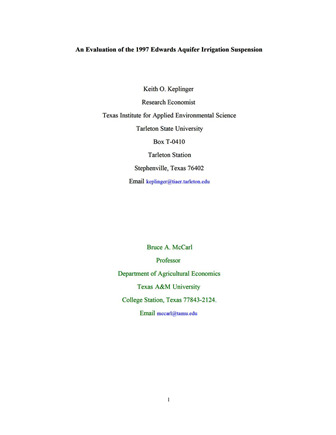An Evaluation of the 1997 Edwards Aquifer Irrigation Suspension

| Author | Keplinger KO (Tarleton State University Texas Institute for Applied Environmental Science) and McCarl BA (Texas A&M University Dept of Agricultural Economics) |
| Description | Evaluation of Edwards Aquifer Authority’s Irrigation Suspension Program in 1997 and alternatives |
| Publisher | Edwards Aquifer Authority |
| Location | Edwards Aquifer Authority Jurisdiction |
| Cover | View Download |
| File | View Download |
| Summary |
|
In early 1997, the Texas Edwards Aquifer Authority implemented a pilot Irrigation Suspension Program (ISP) with the objectives of increasing springflow and providing relief to municipalities during drought. Irrigators were paid $2,350,000 to suspend water use. The price paid per suspended acre was substantially higher than regional lease rates and land prices would imply. The region experienced a wet spring, but estimates show if conditions had been dry, that suspending irrigation would have substantially reduced pumping and augmented critical springflow. Effects on the local economy appeared to be small. We evaluate the ISP and two alternatives: (1) subsidizing more efficient irrigation technology and (2) buying land. The irrigation suspension is a more cost-effective source of critical water than subsidizing more efficient irrigation because it can be put in place only when water is most needed. But land purchases would reduce program cost if the bid levels remained at the level observed in the 1997 program. |
Search for Documents
Advance Search
Explore EAA's Scientific Reports
- All Reports
- RZ Protection
- Aquifer Levels
- Remote Sensing
- Precipitation
- Overview Studies
- Modeling
- Hydrology and Hydrogeology
- History
- Groundwater Recharge, Recharge Zone
- Groundwater Movement
- Geomorphology and Caves
- Weather Modification
- Geology
- Water Use and Conservation
- Geochemistry
- Water Resources Planning and Management
- Floods and Drought
- Water Quality
- Climatology
- Surface Water / Groundwater Relationship
- Biology
- Springs, Groundwater Discharge
- Archaeology
